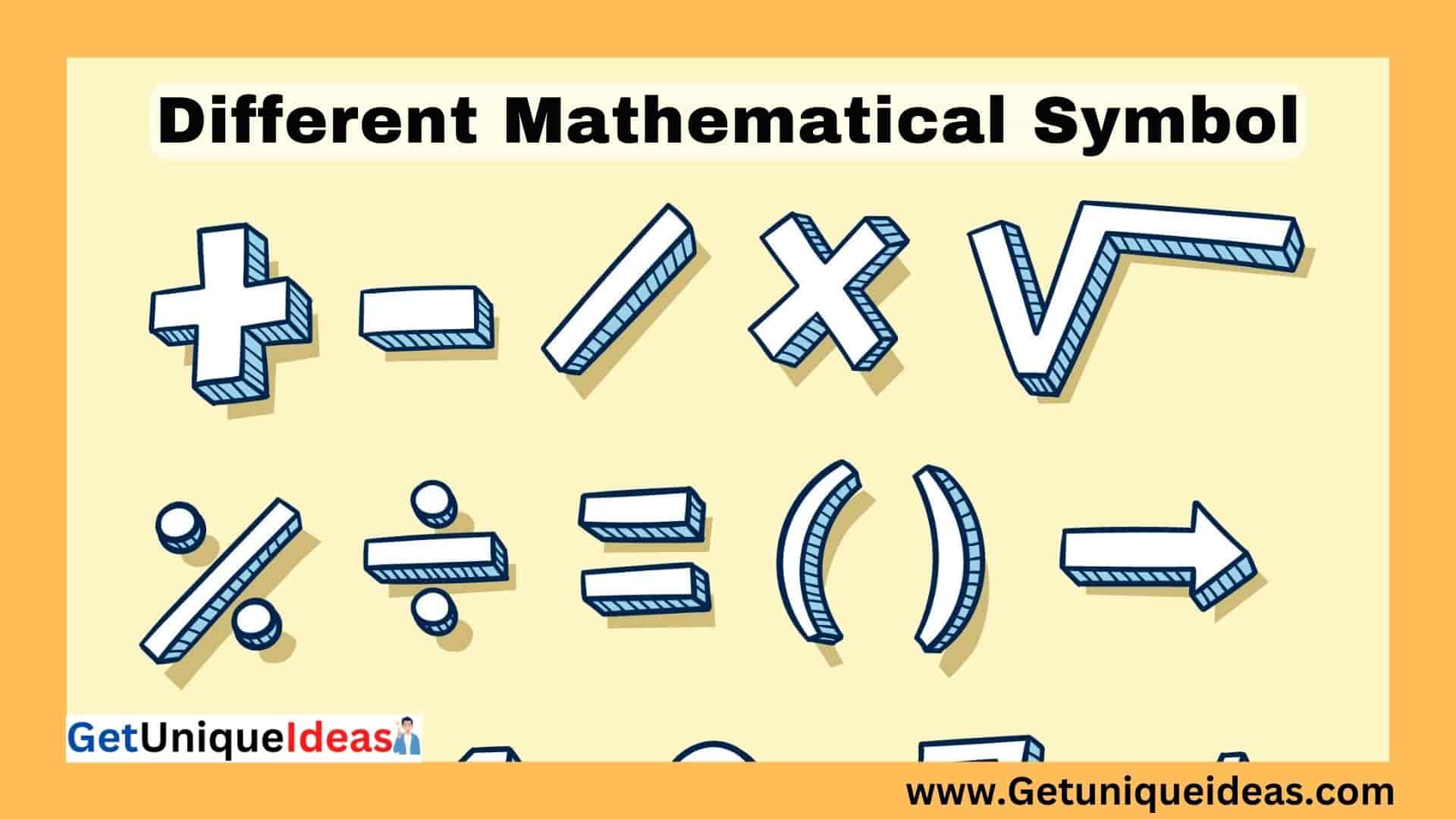Mathematics is a vast field that uses a wide range of symbols and signs to represent mathematical concepts and operations. These symbols and signs are used to make mathematical expressions concise, precise, and unambiguous. In this article, we will explore some of the most commonly used mathematical symbols and signs with their names and meanings.
Mathematical Symbols and Signs

Here’s a table with over 50 commonly used mathematical symbols, along with their names and descriptions:
| No. | Symbol | Name | Description |
|---|---|---|---|
| 1 | + | Plus Sign | Represents addition |
| 2 | – | Minus Sign | Represents subtraction |
| 3 | × or * | Multiplication Sign | Represents multiplication |
| 4 | ÷ or / | Division Sign | Represents division |
| 5 | = | Equal Sign | Indicates that two expressions have the same value |
| 6 | ≠ | Not Equal Sign | Indicates that two expressions do not have the same value |
| 7 | > | Greater Than Sign | Indicates that one expression is greater than another expression |
| 8 | < | Less Than Sign | Indicates that one expression is less than another expression |
| 9 | ≥ | Greater Than or Equal To Sign | Indicates that one expression is greater than or equal to another expression |
| 10 | ≤ | Less Than or Equal To Sign | Indicates that one expression is less than or equal to another expression |
| 11 | ∞ | Infinity Sign | Represents a quantity that is larger than any finite number |
| 12 | π | Pi | Represents the ratio of the circumference of a circle to its diameter |
| 13 | √ | Square Root Sign | Indicates the positive square root of a number |
| 14 | 3√ | Cube Root Sign | Indicates the positive cube root of a number |
| 15 | ∑ | Summation Sign | Represents the sum of a series of numbers |
| 16 | ∏ | Product Sign | Represents the product of a series of numbers |
| 17 | ∫ | Integral Sign | Represents the area under a curve or the anti-derivative of a function |
| 18 | ! | Factorial Sign | Indicates the product of all positive integers up to a given number |
| 19 | % | Percent Sign | Indicates a ratio of a number to 100 |
| 20 | ° | Degree Sign | Indicates a measure of angle in degrees |
| 21 | ∠ | Angle Sign | Represents an angle |
| 22 | ≈ | Approximately Equal Sign | Indicates that two expressions are approximately equal |
| 23 | ≡ | Equivalent Sign | Indicates that two expressions are equivalent |
| 24 | ∝ | Proportional Sign | Indicates that two variables are proportional |
| 25 | ~ | Tilde Sign | Indicates a similar relationship |
| 26 | ∧ | Logical AND Sign | Indicates that two logical statements are true |
| 27 | ∨ | Logical OR Sign | Indicates that at least one of two logical statements is true |
| 28 | ¬ | Logical NOT Sign | Negates a logical statement |
| 29 | → | Conditional Sign | Indicates a logical implication |
| 30 | ↔ | Biconditional Sign | Indicates a logical equivalence |
| 31 | ⊂ | Subset Sign | Indicates that a set is a subset of another set |
| 32 | ⊃ | Superset Sign | Indicates that a set is a superset of another set |
| 33 | ⊆ | Subset or Equal To Sign | Indicates that a set is a subset of or equal to another set |
| 34 | ⊇ | Superset or Equal To Sign | Indicates that a set is a superset |
| 35 | ∅ | Empty Set Sign | Indicates a set with no elements |
| 36 | ∈ | Element of Sign | Indicates that an element belongs to a set |
| 37 | ∉ | Not Element of Sign | Indicates that an element does not belong to a set |
| 38 | ∩ | Intersection Sign | Indicates the set of elements that belong to two or more sets |
| 39 | ∪ | Union Sign | Indicates the set of elements that belong to at least one of two or more sets |
| 40 | ⊕ | Exclusive OR Sign | Indicates that either one or the other of two logical statements is true, but not both |
| 41 | ∆ | Delta Sign | Represents a change or difference |
| 42 | ε | Epsilon Sign | A very small positive number |
| 43 | μ | Mu Sign | Represents the mean or average |
| 44 | σ | Sigma Sign | Represents the standard deviation |
| 45 | ω | Omega Sign | Represents the angular frequency |
| 46 | ℵ | Aleph Sign | Represents the cardinality of infinite sets |
| 47 | ℜ | Real Part Sign | Indicates the real part of a complex number |
| 48 | ℑ | Imaginary Part Sign | Indicates the imaginary part of a complex number |
| 49 | ∴ | Therefore Sign | Indicates a logical conclusion |
| 50 | ∵ | Because Sign | Indicates a logical reason |
These are just some of the many mathematical symbols used in various branches of mathematics, including algebra, calculus, geometry, and more. Familiarizing yourself with these symbols can help you better understand and communicate mathematical concepts and ideas.
Basic Mathematical Symbols

The basic mathematical symbols include the following:
» Plus Sign (+): The plus sign is used to represent addition. For example, 3 + 2 = 5.
» Minus Sign (-): The minus sign is used to represent subtraction. For example, 5 – 2 = 3.
» Multiplication Sign (× or *): The multiplication sign is used to represent multiplication. For example, 3 × 2 = 6 or 3 * 2 = 6.
» Division Sign (÷ or /): The division sign is used to represent division. For example, 6 ÷ 3 = 2 or 6 / 3 = 2.
Advanced Mathematical Symbols
The advanced mathematical symbols include the following:
» Equal Sign (=): The equal sign is used to indicate that two expressions have the same value. For example, 2 + 3 = 5.
» Not Equal Sign (≠): The not equal sign is used to indicate that two expressions do not have the same value. For example, 2 + 3 ≠ 6.
» Greater Than Sign (>): The greater than sign is used to indicate that one expression is greater than another expression. For example, 5 > 3.
» Less Than Sign (<): The less than sign is used to indicate that one expression is less than another expression. For example, 3 < 5.
» Greater Than or Equal To Sign (≥): The greater than or equal to sign is used to indicate that one expression is greater than or equal to another expression. For example, 5 ≥ 5.
» Less Than or Equal To Sign (≤): The less than or equal to sign is used to indicate that one expression is less than or equal to another expression. For example, 3 ≤ 5.
» Infinity Sign (∞): The infinity sign is used to represent a quantity that is larger than any finite number. For example, lim x → ∞ f(x) = L means that the limit of the function f(x) as x approaches infinity equals L.
» Pi (π): Pi is a mathematical constant that represents the ratio of the circumference of a circle to its diameter. It is approximately equal to 3.14159.
» Square Root (√): The square root sign is used to indicate the positive square root of a number. For example, √4 = 2.
» Cube Root (3√): The cube root sign is used to indicate the positive cube root of a number. For example, 3√8 = 2.
» Summation (∑): The summation symbol is used to represent the sum of a series of numbers. For example, ∑n=1^5 n = 1 + 2 + 3 + 4 + 5 = 15.
» Product (∏): The product symbol is used to represent the product of a series of numbers. For example, ∏n=1^5 n = 1 × 2 × 3 × 4 × 5 = 120.
» Integral (∫): The integral symbol is used to represent the area under a curve or the anti-derivative of a function. For example, ∫x^2 dx = (x^3)/3 + C, where C is the constant of integration.

Conclusion
In conclusion, mathematical symbols and signs are an important part of mathematics. They allow for concise and precise communication of mathematical concepts and ideas. From basic arithmetic symbols like “+” and “-” to more advanced symbols like “∫” and “∞”, these symbols are used across various branches of mathematics. By learning these symbols and their meanings, individuals can better understand mathematical concepts, read and write mathematical equations and expressions, and ultimately excel in mathematics.








